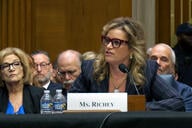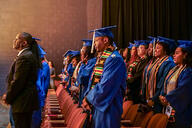You have /5 articles left.
Sign up for a free account or log in.

Andrii Dodonov/iStock/Getty Images Plus
Prior research has shown a gender gap on syllabi in some fields, wherein the authors of assigned readings don’t represent the gender diversity of the field. Other research has demonstrated the positive impact of role models on student success.
A new study in PLOS One combines these two areas of research, focusing on graduate-level course syllabi and role models for graduate students. While the discipline at the heart of the study, political science, is changing -- due in part to efforts such as Women Also Know Stuff -- it has a particular reputation for gender bias. Even so, the authors of the new study say that their at times surprising findings translate to other fields.
What did the researchers find? When they adjusted the share of female authors on a syllabus from 10 percent to 30 percent, female graduate students’ self-efficacy, meaning their perceived likelihood of succeeding in the hypothetical course, was not affected. Male students, meanwhile, showed lower self-efficacy, reporting that they were less likely to succeed in the course when more women appeared on the syllabus.
Students’ attitudes toward diversity in academe also correlated with their reactions to the syllabi more than their own gender did. That is, the gender-diverse, 30 percent-female-author syllabi reduced self-efficacy among students who said they were not supportive of diversity.
In a second experiment, the authors found that students with more academic role models had a higher sense of self-efficacy. This was not related to students’ gender, or to their role models’ gender. At the same time, some students -- namely female students and those who said they valued diversity -- seemed to actively seek out female role models.
“Our results ultimately suggest that exposure to female role models relates in surprising ways to Ph.D. students’ self-efficacy,” the study says. "Having more female role models correlates with greater expectations of academic success among certain groups of students, but with diminished expectations of academic success among other groups.”
Study co-author Amy Erica Smith, Liberal Arts and Sciences Dean’s Professor and associate professor of political science at Iowa State University, said that these findings do not mean that syllabi should include fewer women to accommodate those who apparently don’t see gender diversity as a benefit.
“When we showed students a syllabus with a low percentage of women authors, men expressed greater confidence than women in their ability to do well in the class,” she said. “When we showed students syllabi with more equal gender representation, men’s self-confidence declined, but women and men still expressed equal confidence in their ability to do well. So making the curriculum more fair doesn’t actually hurt men relative to women.”
Instead, she said, increasing women’s representation in readings “just evens things out -- which may feel like a loss to some men.” What’s “particularly stark” about that result, Smith added, is that the “backlash occurred just from increasing the percentage of women authors from 10 percent to 30 percent, so we weren’t even talking about reaching gender parity.”
Co-author Heidi Hardt, associate professor of political science at the University of California, Irvine, said professors have many options for diversifying syllabi today. Along with Women Also Know Stuff, resources include People of Color Also Know Stuff and a gender-coded database of citations that Hardt and Smith developed.
Faculty members may want to reach out to professional networks and disciplinary organizations to learn more about crafting more representative syllabi, Hardt said. And given the variation in students’ attitudes, professors “might also find it useful to have a conversation discussing with students the selection of readings that appear in their syllabi.”
Smith, Hardt and their other co-author, Shauna N. Gillooly, an Irvine graduate student, based their study on a survey of 297 Ph.D. candidates in 50 highly selective programs in the U.S., fielded in late 2019.
Participants in the study read a randomly assigned version of an invented research methods course syllabus. There were four versions of the syllabus, and all were identical except for the assigned readings. On some of the syllabi, only 10 percent of readings were female-authored -- what prior research has shown is the average representation of women in similar graduate-level methods courses in political science. On other syllabi, 30 percent of the authors were women, as other research suggests that group behavior shifts when women reach a “critical mass” of 15 to 30 percent in male-dominated environments.
To get graduate students to think about self-efficacy with respect to their assigned syllabi, the researchers asked respondents a single question: “Do you feel as if you would be successful if you took this course?” Other, more general questions asked whether respondents cared about syllabus diversity and gauged students’ quantitative and qualitative research orientation.
Regarding role models, the researchers described academic role models as those “whom you admire professionally and whose research you admire. Graduate students often identify role models by reading that person’s research, seeing them teach or give a talk, or working for them as a research assistant.” Following that definition, the authors asked students if they’d had role models during their undergraduate or graduate training and how many -- up to six or more role models. The survey also asked students to reflect on their top one or two role models and identify those role models’ genders.
To determine program self-efficacy, students were also asked about how well they fit into their Ph.D. programs; how likely they were to finish, publish and be cited; and how supported they felt by fellow students, their department and their supervisor.
The authors had expected that increasing women’s representation in syllabi would boost their course-related self-efficacy, but that wasn’t the case. Instead, again, men felt slightly less efficacious. Students’ attitudes toward diversity did relate to how they felt about the syllabi and therefore the course, as expected: exposure to the gender-diverse syllabi lowered the likelihood of reporting high course-related self-efficacy by 30 percent for the students least supportive of diversity. The effect was less significant and not statistically significant among students who supported diversity.
Also consistent with what the authors expected, women tended to exhibit homophily in choosing role models: some 77 percent of male students who said they had role models had a same-gender role model, compared to 66 percent of women -- even though women represent between just 27 and 32 percent of professors in political science. Also consistent with researchers’ expectations, faculty role models were associated with a substantial increase in students’ self-efficacy. While 10 percent of students reported having no role models and 7 percent reported six or more, the median student had between three and five role models, and moving from no role models to the sample median was associated with a gain in efficacy of 0.16 on a zero-to-one scale, or one standard deviation of the dependent variable. In another surprise to researchers, however, role model gender did not influence female students’ self-efficacy.
Ultimately, Smith said, “mentoring and role models are extremely important for graduate student success, regardless of student gender or race, and of role model gender or race. It's important for students to find successful professionals with whom they identify, period.”





